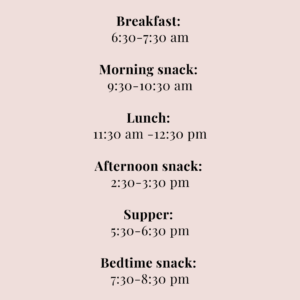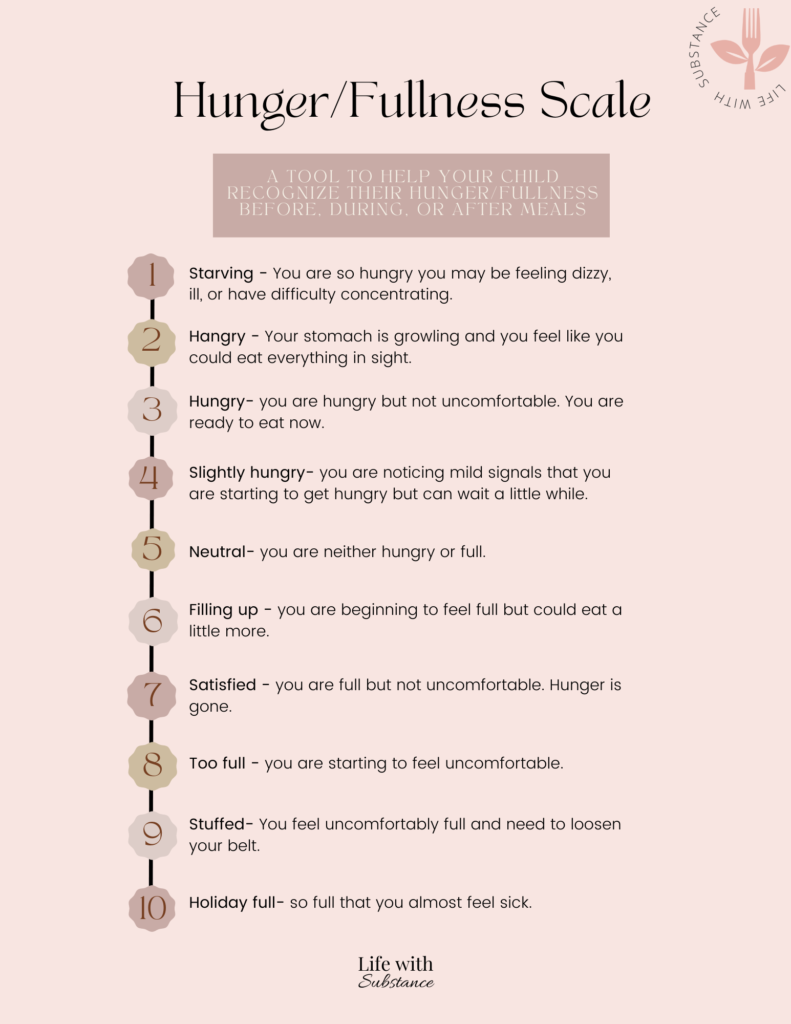This post may contain affiliate links. If you shop from one of our links, we may earn a commission.
Does it feel like your child won’t stop snacking? Does it feel like they snack really well but when it comes to meal times they don’t want to touch anything? Do you feel like a short-order cook because your child doesn’t want to eat the meal you provided? Are you struggling to find ways to encourage your child to want to eat at meals? I used to feel the same power struggle with my kids, and then I discovered an effective system to help them eat better when it came to sitting down for our family meals.
So what’s the difference between snacking and grazing?
When your child won’t stop snacking they generally are not eating enough food to satisfy them until the next meal. They take a few bites, go play, and then come back for another handful after a few minutes. Multi-tasking while eating also prevents kids from being able to listen to their internal cues of hunger and fullness.
Snacking refers to intentional times to sit down and enjoy a safe food (an item they feel comfortable eating). I would encourage you to take this time to sit down and enjoy a snack with your kids. This is a great opportunity to connect and engage with them about their day. Kids love it when their parents are spending time with them.
Snacks are not bad and should not be forbidden, rather they help bridge the gap between meals to prevent your child from showing up overly hungry. Also, let’s be real, your child would probably be a bear if they didn’t eat snacks only to come to the table hangry. Let’s spare everyone the drama because mealtimes should be enjoyable and not stressful. Feeding picky eaters is already a daunting task and we don’t need to add fuel to the fire.
Here are some benefits of snacks
- Snacks can prevent low blood sugars between meals to keep a steady level of energy and prevent irritability
- Helps kids learn to self-regulate hunger and fullness between meals
- Improves mood and concentration
- Helps build a healthy relationship with food and body
Now let’s discuss ways to help your kid be ready for meals if your child won’t stop snacking. Let’s break this process down into a few simple things you can do now!
What to do if your child won’t stop snacking
Create Intentional Meal and Snack Times
The first step is to establish intentional meal and snack times. This helps kids learn to self-regulate their feelings of hunger. Below is an example of snack and mealtime windows. This obviously can be adjusted based on your family’s schedule.

I recommend keeping a 2-hour time gap between meals and snacks to allow time for them to develop hunger cues and feel ready to eat again. It’s best to prevent snacking an hour before meals so they develop a healthy appetite for the meal. Schedules can change from day to day so don’t feel like you have to follow this closely. This is meant to be a guide to help both you and your kids know when to expect it’s time to eat.
Younger kids need 3 meals and 2-3 snacks per day while older kids are generally fine with 3 meals and 1 snack. However, if your child is going through a growth spurt they are likely more hungry and may require an additional snack or larger servings.
Having set time frames for snacks and meals is really important for kids who need to gain weight and need to get in enough calories during the day. Many parents think that if their child is underweight they should allow them to eat as much food as they want at all times of the day. The problem with this is that they graze all day on snacks and then aren’t hungry when it comes to meals. And meals are generally where kids eat more food groups -such as protein, grains, fruits, vegetables, and dairy.
Picky Eaters
If you have a picky eater on your hands and feel they don’t eat well at meals, then download my free picky eater guide on ways to help your child eat a variety of foods. If your child knows they can skimp on meals and fill up by grazing on snacks then they likely will just eat a little bit or push their plate away during meals. Work on offering nutritious foods during snacks to ensure they are still getting a balanced diet. And remember to keep on being consistent with established meal and snack times.
I like to use the phrase “kitchen is closed” with my kids. I remind them that the kitchen will open again shortly for the next meal or snack, but until then let’s find other activities. For young ones, this phrase seems to resonate well with them. It offers them assurance that food will be available again soon, but in the meantime searching the cupboards as a pastime is not an option.
Connect and Engage by Sitting Down
The second tip may sound silly, but it really does work! Have your child SIT DOWN any time they eat. I realize this is much easier said than done when you have busy little ones. My oldest is 8 years old and needs to constantly be moving. I feel like a broken record most meals telling her to sit back down. Kids don’t like to sit for long periods of time. Often times kids want to take a few bites, get up and play, and then come back for more food and this leads to grazing. While we know it’s likely inevitable to happen, our goal is to keep them focused on eating during their time window.
Find a designated spot in the house as an “eating-only zone”. The best place for this is generally the kitchen table or countertop. This can help you better monitor how much your child is eating but also helps to limit distractions. Studies show that kids who are reoccupied while eating in front of the television are more likely to eat mindlessly which can lead to weight gain.
Hunger and Fullness Cues
Learning internal cues of hunger and fullness takes time and many of us no longer know what hunger and contentment feel like. I’m sure you have experienced this before in your own life. For example, maybe you were on a “diet” and trying to make wise food choices and avoid overeating. So you ate a small breakfast, and a light lunch, but come 4 o” clock you felt famished. You try not to snack because you know supper is coming soon. But once you sit down to eat you have lost all sense of your hunger and fullness cues and eat more than you cared to admit. After the meal, you felt guilty for overindulging causing you to feel like a failure.
While kids are hopefully not on some sort of diet, they are likely experiencing these same types of feelings of hunger when they come to the dinner table if snacks were removed. By the time supper comes around, kids have already had a full day at school, sports, or other activities and need to refuel. If they come to the table overly hungry, they will overeat. And consistently eating beyond the feeling of content can lead to excessive weight gain over time. As parents, our job is to help teach our kids what these internal cues feel like. And snack time may be just what your child needs to help better manage their hunger and fullness.
How do I help my child understand hunger and fullness cues?
Hunger can be experienced in a variety of ways. Here are some helpful tips to watch for in young children who may have a hard time knowing how to verbalize how they feel. Stomach growling is an obvious sign of hunger, but there are others to watch for as well. For example, if you notice symptoms such as being tired or sluggish, irritable, short attention span, or difficulty concentrating, your child may need a snack to hold them over until their next meal. I absolutely love using a hunger/fullness scale to help kids describe how they feel and give you a better idea of how you should feed your child.
Use a scale of 1-10 each time you sit down for a snack or meal. This tends to be a more effective scale for kids around 4 or 5 years of age and above. The goal is to keep their hunger and fullness levels between 3-7. When your child is at a level 3 on the scale this means they are beginning to feel hungry and if you don’t feed them soon they will hit the point of becoming overly hungry. And we all know that when a child is overly hungry they are more likely to have meltdowns or become irritable. Isn’t that true for adults too!? It makes me think of the Snickers commercial – you aren’t yourself when you’re hungry.
If your child finishes their snack or meal and requests more, take a minute to ask them how they would rank themselves on the scale. Allow them seconds if they truly aren’t satisfied.
Limit distractions to help if your child won’t stop snacking
Again, I highly encourage all meals and snacks to be eaten in the kitchen with limited distractions. Try to avoid the usage of phones, TV, toys, or anything else that may interfere with their ability to concentrate on their food and if they feel content with the volume they consume.
This method was not just designed for children. I preach this theory to adults as well to encourage a better relationship with food and honoring your hunger and fullness.
Little ones and how to use the hunger/fullness scale
For little ones who aren’t old enough to grasp the hunger and fullness scale yet it becomes important for you as the parent to observe their mood and how you are managing their day. Key items to remember:
- Are we sticking to a schedule and is there an appropriate gap between meals?
- Are meals and snacks being eaten on the go or at the table?
- Are they consuming enough to fill them up at meals or snacks? Or are they constantly asking for food as soon as they leave the table?
If you find your picky eater is following a schedule but still seems irritable and asking for more food, then consider adding additional safe foods at their meal or snack. Safe foods are foods that you know they enjoy. They may eat more of this to help fill them up at a meal while learning to adapt to new foods. For example, this may include favorite foods such as cottage cheese, applesauce, yogurt, fruit, string cheese, etc. They are foods they will consume at the table and, if they eat nothing else at that meal, they can still walk away feeling content.
Picky eaters and food refusal don’t correct themselves overnight. But it’s still our job as parents to make sure they stay nourished while we wait for them to try different foods. Some kids may struggle with sensory issues as well making meal and snack times more difficult. Consult your pediatrician if you notice your child has a lot of sensory issues preventing them from increasing variety in their diet.
What if my child is ranking themselves at a 2 on the hunger scale and it’s not time to eat yet?
Grant them permission to have a small snack to hold them over until snack time. The goal is to not make this a habit that can lead to grazing. There are some days when kids just expend more energy and feel extra hungry. That’s okay if it’s not a daily occurrence. Work on getting to a set routine when you can.
Division of Responsibility
Division of Responsibility in Feeding in Ellyn Satter’s book is so helpful. Her theory simply put is:
Your job as the parent: Prepare and serve the food. That’s it! You can feel satisfied with what you put on the table. In the end it is the child’s job to take it from there.
The child’s job: Decide IF and HOW MUCH they will eat.
Do you feel so much pressure was relieved from you as the parent? Yep, it’s truly that simple. This is a really hard mindset shift for many parents, but it really does work. There was actually a study released in 2002 that showed 72% of adults that were forced to eat certain foods in their childhood still refuse these foods now. WHOA!! That blows my mind! But it also shows that we majorly need to shift how we are feeding our kids today.
Sustainable Snacks
Alright, so now that we have our guidelines in place to help us be successful let’s discuss how to create a sustainable snack. If you have a chronic grazer on your hands, they are likely inclined to want a few handfuls of food every now and then because that’s what they’re used to. Because you want at least a 1-2 hour gap between meals to develop an appetite for the next meal, you are going to need a sustainable snack to get them through.
Protein takes longer to digest, helping your child feel satisfied for longer. I recommend pairing a carb with a protein at each snack. This doesn’t mean all their snacks have to win an Instagram “healthy snacks” of the year award. For example, their snack may include Goldfish (carb) and nuts (protein).
Should I allow my child a bedtime snack?
I get this question a lot from parents so I wanted to address it here. While every family is different in their schedules, I do think there are a few things to consider when deciding whether or not you should offer a snack before bed.
Remember that meal and snack schedule we talked about? Keeping meals 1-2 hours apart is the goal to help if your child won’t stop snacking. If your family typically eats an early supper (say around 5 o’clock), but your kids don’t go to bed until 8 then that’s a 3-hour window since they last ate. If this is your general routine, a bedtime snack is probably a good idea for your kids. Also, there are evenings when you may have a lot going on and don’t get home till later. In this case, your child may need a snack to hold them over until breakfast.
Evaluate your child’s behavior. Is your child waking in the night asking for a snack? Do they come to breakfast overly hungry and cranky? If this is the case, you likely should implement a nighttime snack as part of their usual routine.
A few more things to consider about bedtime snacks…
- Offer something filling, not thrilling. If your child knows they can have ice cream or other sweets as a bedtime snack, then they’ll always demand a bedtime snack. Packaged snacks are fine during the day, but I recommend limiting them at night. Offer something that you know your child will eat. My go-to snack for my kids at night is fruit and string cheese. Other options may include bread with peanut butter, yogurt, and fruit, or a glass of milk with carrot sticks. Remember to follow the same eating rules we discussed of eating at the table and avoiding distractions.
- If your child is requesting more food when putting them to bed, gently remind them that the kitchen will open in the morning for breakfast. Often times kids use hunger as a way to put off going to bed. As a parent, you can rest assured that they are fed and will be fine until morning.
And remember, at the end of the day we are working on progress, not perfection. Take it one day at a time. Some days you may follow all these steps perfectly and feel like it was a win getting your picky eater to try a variety of healthy foods. And other days it will all fall apart. In the long run, you are helping your kids develop healthy eating habits. Way to go, Mom!
Let me know how this system worked for your family at hello@lifewithsubstance.com! I would love to hear other tricks that you find work well for your family.


